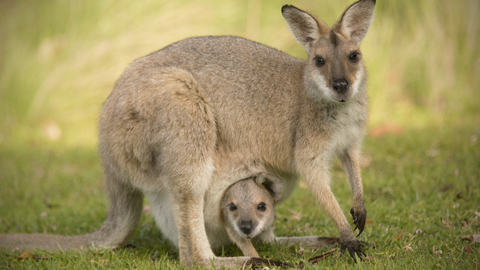New findings on the peculiar sex chromosomes of marsupials
A study led by UAB researchers provides new data on the behaviour of sex chromosomes in marsupial sperm precursor cells, including a telomere-related lengthening mechanism previously unknown in the chromosomes of other mammals. The results of the study, published in PLOS Genetics, represent a breakthrough in the understanding of the function of genome organisation in the species.

An international research team led by the UAB describes new mechanisms regulating sperm formation in several species of marsupials and which differ from those previously described in other mammals, such as humans and mice.
The study, published in the journal PLoS Genetics, was led by Aurora Ruiz-Herrera, researcher at the UAB Department of Cell Biology, Physiology and Immunology, and at the Institute of Biotechnology and Biomedicine (IBB), and carried out by Laia Marín (first author of the study), Laura González and Gala Pujol, researchers of the Animal Genomics group, coordinated by Aurora Ruiz-Herrera. Researchers from the Universidad Autónoma de Madrid, the University of New South Wales, Melbourne and Chile also collaborated in the study.
Investigating the dynamics of gene expression in sex chromosomes of marsupials may provide new functional and evolutionary clues, since this group of mammals is the previous link to the form of the sex chromosomes of eutherian mammals (with internal placenta), with which they last shared a common ancestor 185 million years ago.
The chromosomes determining the biological sex of an individual (X and Y chromosomes in mammals) are different between marsupials and eutherian mammals. The lack of a shared region or homology in marsupials offers a unique opportunity to explore the behaviour of their sex chromosomes during meiosis, the process by which gametes (eggs and sperm) are formed. The work describes different configurations and behaviours of sex chromosomes during meiosis and a reduction in chromosomal recombination. "It shows that the regulation of their sex chromosomes is different, not only with respect to eutherian mammals, but also among different species of marsupials, which could have important functional and evolutionary consequences for the correct formation of gametes", says Aurora Ruiz-Herrera.
The research also includes the unknown detection in mammals of a mechanism related to the lengthening of the ends of their chromosomes, the telomeres, during the formation of spermatozoa. Known as ALT, this mechanism "was initially associated exclusively with tumour cells, but now we have discovered that it is also found regulating telomeres during sperm formation, at least in some species of marsupials", explains Laia Marín. "In fact, future studies of the ALT mechanism in sperm precursor cells will provide new insights into the role telomere regulation plays in the high incidence of tumours detected in some marsupial species", she adds.
The study was performed on testicular tissue from two species of Australian marsupials (tammar wallaby and the thick-tailed marsupial mouse) and one species of South American marsupial (the elegant fat-tailed mouse opossum). There are currently about 270 species of marsupials, mostly in Australia and to a lesser extent in the American continent.
The research shows that marsupials are a good model to explore the great diversity in the mechanisms regulating gamete formation and represent an advance in the knowledge about the function of the organisation of the genome of the species.
"The comparative study of the process of gamete formation in different mammalian species shows that there are differences between different phylogenetic groups with important functional and evolutionary implications", concludes Aurora Ruiz-Herrera.
Article: Marín-Gual et al. (2022). Strategies for meiotic sex chromosome dynamics and telomeric elongation in Marsupials. PLoS Genetics 18(2): e1010040. doi: 10.1371/journal.pgen.1010040. https://dx.plos.org/10.1371/journal.pgen.1010040